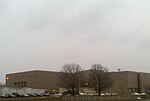Washington's Birthday Marathon
Washington's Birthday Marathon is an annual marathon in the United States that has been held nearly every February since 1962. It is held each year on the Sunday of Washington's Birthday Weekend and is conducted by the DC Road Runners Club. The race was originally held in Arlington, Virginia, but after a few years, it was moved to Beltsville, Maryland. Finally, it was relocated to Greenbelt, Maryland. The Greenbelt course started and finished at the recreation center of the NASA Goddard Space Flight Center and consisted of three loops around the Beltsville Agricultural Research Farm. When NASA permanently closed access between the rec center and Good Hope Road, the race start was moved to Duvall High School, and finally to the Greenbelt Youth Center. The race continues to consist of three loops on the farm.A three-person relay is also held at the same time.
Excerpt from the Wikipedia article Washington's Birthday Marathon (License: CC BY-SA 3.0, Authors).Washington's Birthday Marathon
Northway,
Geographical coordinates (GPS) Address Nearby Places Show on map
Geographical coordinates (GPS)
| Latitude | Longitude |
|---|---|
| N 39.005833333333 ° | E -76.880277777778 ° |
Address
Northway 100
20770
Maryland, United States
Open on Google Maps






